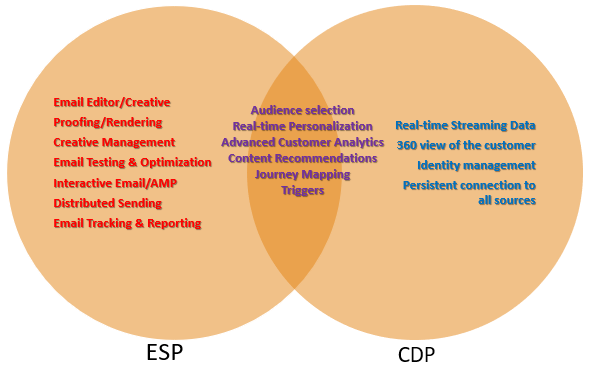Worlds Collide: The Head-on Crash of CDPs and ESPs
Any discussion of the features and functionality of ESPs vs. CDPs needs to start with the ESP platforms. ESPs have been around in one form or another for over 20 years, and it should be well-estalbished these days as to what constitutes an ESP. Ah, if only it were so easy. Fun Fact: there are much bigger differences between email vendors than most email marketers realize.
These differences are rarely addressed in detail by analysts like Forrester—who rank everyone together in a single ESP wave report, and then turn around and rank many of the same players in a CCCM wave report. And the vendors are no better, with sales teams who never met a prospect for which their platforms aren’t a perfect fit! Making matters even more confusing for the poor email marketer is the fact that most vendors don’t even call themselves ESPs any longer! It’s almost as if there is a stigma associated with those 3 letters. And yet in truth, no one runs an RFP for a “Growth Marketing Platform.” They run RFPs for Email Services Providers. And that’s as it should be, since email marketing is what is, and what should be, driving the decision process in these RFPs.
The ESP Landscape
Today’s ESP vendor landscape can be organized into 5 distinct categories, each with different approaches to technology, services, and priorities. Let’s take a look at each of these groups in more detail…
Marketing Service Providers
- Examples: Zeta Global, Epsilon
- 5 years ago this group was the dominant category of ESP
- Traditionally services-oriented, including creative and analytics, on top of campaign production; can provide clients with full-service relationships
- Deep understanding of data and database marketing; able to ingest and leverage large volumes of data
These ESPs are best suited for enterprise brands that want to store large volumes of structured and unstructured data in their ESP; brands that want access to a broad range of agency services from their email vendor; and brands interested in 3rd party data appends to their email databases.
Marketing Clouds
- Examples: Salesforce, Adobe, Oracle
- These email platforms are parts of larger, integrated suites of marketing tools offered by the providers
- Parent companies see themselves as technology companies, not marketing companies, so they don’t offer a range of services—instead they depend on third-party agencies to provide services to their clients
- Continue to acquire niche vendors with dynamic personalization offerings, data tools and assets, and predictive analytics capabilities
These platforms are best suited for enterprise brands already heavily invested in a parent company’s marketing cloud products. They are not ideal vendors in an email point solution role.
Transactional
- Examples: SendGrid, Sparkpost, Pepipost
- Officially known as Email API and SMTP transactional email services. Also known as “MTA’s in the Cloud” (credit David Daniels, The Relevancy Group)
- Bare-bones platforms, bare-bones services and support
- Designed for developers and IT with easy to integrate and extensive API’s; rudimentary UX tools for promotional emails
Best suited today for brands sending large volumes of transactional emails (i.e. one-off emails sent in real-time based on some type of event). Brand marketers often struggle with these platforms when setting up and mailing promotional (or batch) email campaigns.
Point Solutions
- Examples: Sailthru, Emarsys, dotdigital
- As in the martech category in general, the email point solutions category remains highly fragmented and is continuously evolving in multiple directions, resulting in rapid vendor proliferation and brutal competition
- Many of today’s key players in this category got their start in Europe, and were built from the ground up as multichannel solutions
Best suited for mid-market and low enterprise email marketers who are multichannel marketers.
Unicorns
- Examples: Iterable, MessageGears, Braze
- Unique platforms with specialized capabilities around particular needs like mobile first, UX enhancement or data management
In the right situations, these ESPs can help solve seemingly intractable problems. Unicorns often don’t have direct competitors in the market; evaluating them in any RFP process requires a deep understanding of the differences they represent.
The CDP Landscape
So now that you have a better understanding of the ESP market, one might think you’d be all set. But that’s not how life works. Once again, a “next big thing” has come along and now email marketers like yourself are being told that your stack isn’t complete without a CDP. Why does this keep happening?!
Because we’ve been fed hyperbole like this about customers for 20 years from the “experts:”
Consumers increasingly expect real-time, personalized customer experiences—experiences that seamlessly blend the lines between different channels and departments.
And the “next big thing” always promises to bring us closer to that vision. 20 years is no exaggeration. Go back and read what Gartner Group was saying in the late 90s (when they weren’t warning about Y2K).
Remember earlier I said that few, if any, ESP wants to be called an ESP these days? Well we have the exact opposite problem when dealing with CDPs. Every martech platform launched in the last several years has now discovered that it is, in fact, a CDP. DMPs? They already collided with CDPs and the CDPs came out ahead on that one. When everyone is a CDP, trying to define exactly what one is becomes quite challenging. But I will try my best.
In order to be a CDP, a system has to be able to support unstructured data, be highly flexible, act as a true integration hub, not be proprietary in nature, and be real-time from an access standpoint. CDPs should have open APIs that anyone can write to and can provide access to any customer systems.
To be a true customer data platform, all these boxes must be checked (which isn’t the case for almost all vendors currently trying to call themselves a CDP). Many predictive and B2B analytics vendors are claiming to be CDPs because they had to aggregate customer data to do their jobs in the first place—but that doesn’t make a platform a CDP.
Confusing? You bet!
But let’s pretend for a minute that we can all agree on my definition of a CDP (I can already hear Jordie van Rijn saying, “But wait!”). Now let’s take a look at what a CDP is supposed to do.
- Data Aggregation: Organize all customer data and keep it available for immediate use. Some technical resources are required to set up and maintain the CDP, but thye don’t require the level of technical skill needed to operate traditional data warehouse.
- Data Unification: Combine data from multiple online and offline to create a unified single customer view. This 360-degree view of the customer is possible due to the fact that all customer data is located in one central location.
- Data Deployment: On demand deployment of data to 3rd party systems focused on adtech and campaign delivery.
Right about now many of you might be thinking to yourselves, “Hold on one minute, that sounds suspiciously like what I get from my ESP!” And you’d be right. Many mid-market and enterprise ESPs have evolved into tools that help brands manage the entirety of a customer relationship, including:
- communications via email and other channels
- sync with third-party systems via batch and/or real-time methods
- out-of-the-box API's and data export functionality
- ability to capture additional profile attributes where missing and/or enhance with 3rd party data sources
This would seem to imply, then, that there is a lot of overlap between certain ESP platforms and CDPs. You bet there is, and it’s big. This diagram points out some of these overlaps, but it only scratches the surface.

So now it’s game time! After all that we have reviewed to this point, you still need to be able to answer this question: Under what circumstances would your company need to add a CDP to its stack?
The answer is a definitive “it depends”. Depending on your ESP vendor, you might, in fact, already have one! Zeta Global, Cheetah Digital, Adobe and Oracle are among the platforms that can credibly claim to have a “CDP Inside.” And they aren’t the only ones. On the other hand, if you are using a transactional platform like Sparkpost or SendGrid, a CDP may make a lot of sense.
So I will leave you some useful advice on what you and your organization should do next if you are considering adding a CDP to your marketing stack. If you follow these five steps your outcome is much more likely to be a successful one!
- Understand and recognize that there are very real and significant differences between the various ESPs. The same is true regarding CDPs.
- Understand and recognize that there are significant overlaps between ESPs and CDPs.
- Get a handle on your unique and critical requirements—what is going to make your digital marketing program more successful?
- Determine whether an ESP with a CDP inside or a CDP plus an ESP is a better fit for your organization (assuming you feel you MUST have the capabilities of a CDP in the first place).
- Use an objective scoring system to manage the selection process.
And if it all seems to be a little too much to do on your own, here at Email Connect we’re always ready to help you navigate your company’s journey to the best solution (and remember, that might be no solution at all!).
Or you could simpy sit back and do nothing. Gartner Group predicts that the perils of providing personalized experiences will lead marketers to abandon the efforts by 2025. Demonstrating ROI and managing customer data and consent will simply prove too hard for marketing teams trying justify the expense.
Are we having fun yet?

 How to resolve AdBlock issue?
How to resolve AdBlock issue? 
